|
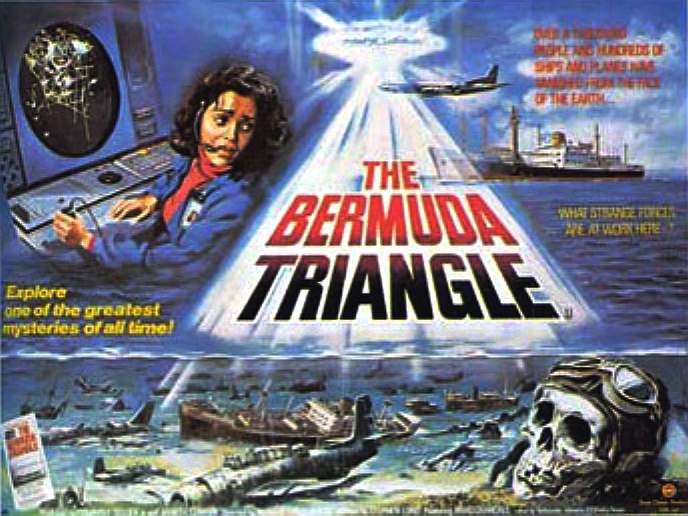
Bermuda
(fully, The Bermuda Islands, alias The Somers Isles) is an
overseas territory of the United Kingdom in the North Atlantic Ocean,
situated around 640 miles (975 km) off the coast of the United
States. The oldest remaining British overseas territory, it was settled
by England a century before the Acts of Union, and two centuries before
the creation of the United Kingdom. Although commonly referred to in the
singular, it consists of around 138 islands, of total area 58.8 square
kilometres (27.7 sq. mi). Compiling a list of these islands is
often complicated, as many have more than one name (as does the entire
archipelago, which, in addition to its two official names, has
historically been known as La Garza, Virgineola, and the Isle
of Devils). Despite the limited land mass, there has also been a
tendency for place names to be repeated (there are two Long Islands,
for instance, and two Long Bays, and the town of St. George
is located on the island and within the parish of St. George's).
The largest island, Main Island (also called Bermuda, or Great
Bermuda), is the location of the capital, the City of Hamilton
(which is in Pembroke Parish, and is often confused with Hamilton
Parish). Bermuda has a thriving economy, with a large financial
sector and tourism industry.
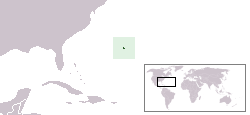
Bermuda
world locator map
Geography
Bermuda
is located in the North Atlantic Ocean roughly 580 nautical
miles (1074 kilometers) east-southeast of Cape Hatteras on the Outer
Banks of North Carolina and roughly 590 nautical miles (1093 kilometers)
southeast of Martha's Vineyard. There are two incorporated
municipalities in Bermuda; the City of Hamilton, and the Town of St.
George. There are also a number of localities which are sometimes termed
villages, among them Flatts Village, Tucker's Town and Somerset Village.
Contrary
to common misconception, Bermuda is not located within the tropics. The
subtropical climate is influenced by the Gulf Stream. Bermuda has a very
humid climate and, as a result, the summer-time heat index can be very
high, even when the actual temperature seems moderate. Winters are mild
with average daytime temperatures in January and
February around 20
degrees celsius. The powerful winds and heavy rain mean that the felt
temperature can fall below freezing, even though the actual temperature
may rarely drop much below 10° C. The only source of fresh water in
Bermuda is rainfall, which is collected on roofs and catchments, or
drawn from underground 'lenses', and stored in tanks (of which, each
dwelling usually has at least one forming part of its foundation).
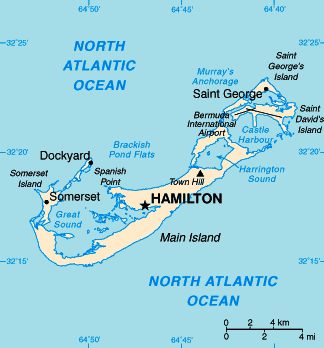
Map
of Bermuda
Economy
Bermuda,
as offshore domicile of many foreign companies, has a highly developed
economy focused on international business and tourism. Its per capita
income is approximately 50% higher than in the United States. CIA data
shows a GDP of $4.5 billion in 2004, per capita, $69,900. Based on 2004
data, Bermuda has the highest GDP per capita in the world.
Bermuda
is regarded as a premier offshore
business jurisdiction, with no direct taxes on personal or corporate
income. The local tax system is based upon import duties, and payroll
and consumption taxes. Many leading international insurance
companies are based in Bermuda and the island is considered the world's
reinsurance centre. Bermuda is a financial exporter both in insurance
and other financial services.
Tourism
is the second largest industry, with the island attracting most of its
visitors from the United States, Canada and the United Kingdom. Much of
this traffic arrives at Bermuda International Airport, the country's air
link to the outside world.
The
currency used is the Bermuda dollar which is pegged to the US
dollar. Bermudian notes carry the image of HM
Queen Elizabeth II. US Dollars and coins are used interchangeably
with Bermudian notes and coins within the islands.
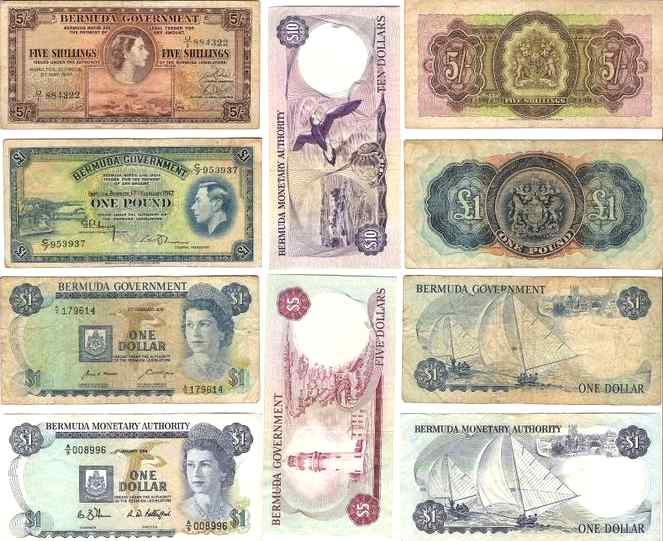
Bermudian
banknotes
Demographics
54.8%
of the population is listed as black, 34.1% as white and 6.4% as Mixed
Race . The island has a growing Asian community. A significant segment
of the population is of Portuguese heritage, the result of immigration
from Portuguese islands, especially the Azores, over the past century.
It
should be noted that these racial demographic terms are misleading. A
small minority the island's black population has a diverse ancestry,
including significant European and Native American bloodlines.
Portuguese Bermudians are often thought of as constituting a separate
racial group, as is the case with Hispanics in the USA. Immigrants from
Portuguese islands included blacks from the Cape Verde Islands, and many
Portuguese intermarried with black and 'white' Bermudians. Consequently,
there are many islanders with Portuguese ancestry, heritage, and names
who are not considered among the 10% of the population typically listed
as 'Portuguese'. Racial identity and labelling became a hot topic with
the last census, which offered greater flexibility in how respondents
could identify themselves racially. Resurgent interest in the island's
Native American past, especially in St. David's, is leading many to
identify themselves with the various Algonquian peoples sold into
slavery on the island during its first century of settlement.
In
addition to large-scale Portuguese immigration, which began with several
families from Madeira in the 1840s, there has been sustained immigration
from the West Indies over the past century. English is the official
language. Portuguese is also spoken by a minority of the population,
mostly Azorean immigrants.
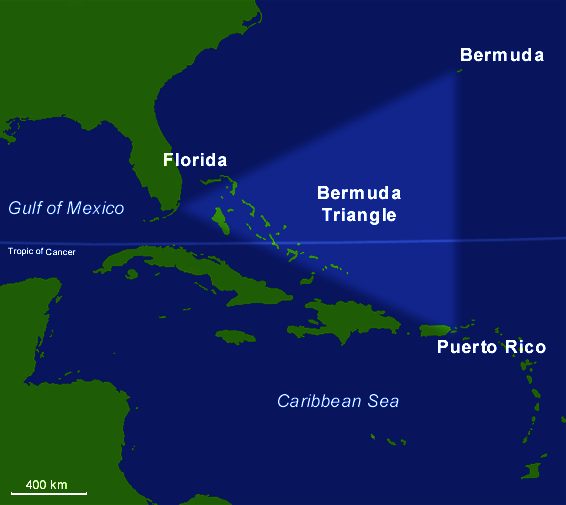
TRIANGLE
The Bermuda Triangle, also known as the Devil's Triangle, is an undefined region in the western part of the North Atlantic Ocean where a number of aircraft and ships are said to have disappeared under mysterious circumstances. The triangle does not exist according to the
US Navy and the name is not recognized by the US Board on Geographic Names. Popular culture has attributed various disappearances to the paranormal or activity by extraterrestrial beings. Documented evidence indicates that a significant percentage of the incidents were spurious, inaccurately reported, or embellished by later authors. Contrary to popular belief, insurance companies do not charge higher premiums for shipping in this area.
Triangle area
Writers give different boundaries to the triangle, with the total area varying from 500,000 to 1.5 million square miles. Consequently, the determination of which accidents have occurred inside the triangle depends on which writer reports them. The first written boundaries date from a 1964 issue of pulp magazine Argosy, where the triangle's three vertices are in Miami, Florida peninsula; in San Juan, Puerto Rico; and in the mid-Atlantic island of Bermuda. The United States Board on Geographic Names does not recognize this name, and it's not delimited in any map drawn by US government agencies.
The area is one of the most heavily traveled shipping lanes in the world, with ships crossing through it daily for ports in the Americas, Europe, and the Caribbean Islands. Cruise ships are also plentiful, and pleasure craft regularly go back and forth between Florida and the islands. It is also a heavily flown route for commercial and private aircraft heading towards Florida, the Caribbean, and South America from points north.
TRIANGLE HISTORY
Origins
The earliest allegation of unusual disappearances in the Bermuda area appeared in a September 16, 1950 Associated Press article by Edward Van Winkle Jones. Two years later, Fate magazine published "Sea Mystery at Our Back Door", a short article by George X. Sand covering the loss of several planes and ships, including the loss of Flight 19, a group of five U.S. Navy TBM Avenger bombers on a training mission. Sand's article was the first to lay out the now-familiar triangular area where the losses took place. Flight 19 alone would be covered again in the April 1962 issue of American Legion magazine. It was claimed[by whom?] that the flight leader had been heard saying, "We are entering white water, nothing seems right. We don't know where we are, the water is green, no white." It was also claimed that officials at the Navy board of inquiry stated that the planes "flew off to Mars." Sand's article was the first to suggest a supernatural element to the Flight 19 incident. In the February 1964 issue of Argosy, Vincent Gaddis's article "The Deadly Bermuda Triangle" argued that Flight 19 and other disappearances were part of a pattern of strange events in the
region. The next year, Gaddis expanded this article into a book, Invisible Horizons.
Others would follow with their own works, elaborating on Gaddis' ideas: John Wallace Spencer (Limbo of the Lost, 1969, repr. 1973); Charles Berlitz (The Bermuda Triangle, 1974); Richard Winer (The Devil's Triangle, 1974), and many others, all keeping to some of the same supernatural elements outlined by Eckert.
Larry Kusche
Lawrence David Kusche, a research librarian from Arizona State University and author of The Bermuda Triangle Mystery: Solved (1975) argued that many claims of Gaddis and subsequent writers were often exaggerated, dubious or unverifiable. Kusche's research revealed a number of inaccuracies and inconsistencies between Berlitz's accounts and statements from eyewitnesses, participants, and others involved in the initial incidents. Kusche noted cases where pertinent information went unreported, such as the disappearance of round-the-world yachtsman Donald Crowhurst, which Berlitz had presented as a mystery, despite clear evidence to the contrary. Another example was the ore-carrier recounted by Berlitz as lost without trace three days out of an Atlantic port when it had been lost three days out of a port with the same name in the Pacific Ocean. Kusche also argued that a large percentage of the incidents that sparked allegations of the Triangle's mysterious influence actually occurred well outside it. Often his research was simple: he would review period newspapers of the dates of reported incidents and find reports on possibly relevant events like unusual weather, that were never mentioned in the disappearance stories.
Kusche concluded that:
The number of ships and aircraft reported missing in the area was not significantly greater, proportionally speaking, than in any other part of the ocean.
In an area frequented by tropical storms, the number of disappearances that did occur were, for the most part, neither disproportionate, unlikely, nor
mysterious.
Furthermore, Berlitz and other writers would often fail to mention such storms or even represent the disappearance as having happened in calm conditions when meteorological records clearly contradict this.
The numbers themselves had been exaggerated by sloppy research. A boat's disappearance, for example, would be reported, but its eventual (if belated) return to port may not have been.
Some disappearances had, in fact, never happened. One plane crash was said to have taken place in 1937 off Daytona Beach, Florida, in front of hundreds of witnesses; a check of the local papers revealed nothing.
The legend of the Bermuda Triangle is a manufactured mystery, perpetuated by writers who either purposely or unknowingly made use of misconceptions, faulty reasoning, and sensationalism.
Further responses
When the UK Channel 4 television program The Bermuda Triangle (1992) was being produced by John Simmons of Geofilms for the Equinox series, the marine insurance market Lloyd's of London was asked if an unusually large number of ships had sunk in the Bermuda Triangle area. Lloyd's of London determined that large numbers of ships had not sunk there. Lloyd's does not charge higher rates for passing through this area.
United States Coast Guard records confirm their conclusion. In fact, the number of supposed disappearances is relatively insignificant considering the number of ships and aircraft that pass through on a regular basis.
The Coast Guard is also officially skeptical of the Triangle, noting that they collect and publish, through their inquiries, much documentation contradicting many of the incidents written about by the Triangle authors. In one such incident involving the 1972 explosion and sinking of the tanker SS V. A. Fogg, the Coast Guard photographed the wreck and recovered several bodies, in contrast with one Triangle author's claim that all the bodies had vanished, with the exception of the captain, who was found sitting in his cabin at his desk, clutching a coffee cup. In addition, V. A. Fogg sank off the coast of Texas, nowhere near the commonly accepted boundaries of the Triangle.
The NOVA/Horizon episode The Case of the Bermuda Triangle, aired on June 27, 1976, was highly critical, stating that "When we've gone back to the original sources or the people involved, the mystery evaporates. Science does not have to answer questions about the Triangle because those questions are not valid in the first place... Ships and planes behave in the Triangle the same way they behave everywhere else in the world."
David Kusche pointed out a common problem with many of the Bermuda Triangle stories and theories: "Say I claim that a parrot has been kidnapped to teach aliens human language and I challenge you to prove that is not true. You can even use Einstein's Theory of Relativity if you like. There is simply no way to prove such a claim untrue. The burden of proof should be on the people who make these statements, to show where they got their information from, to see if their conclusions and interpretations are valid, and if they have left anything out."
Skeptical researchers, such as Ernest Taves and Barry Singer, have noted how mysteries and the paranormal are very popular and profitable. This has led to the production of vast amounts of material on topics such as the Bermuda Triangle. They were able to show that some of the pro-paranormal material is often misleading or inaccurate, but its producers continue to market it. Accordingly, they have claimed that the market is biased in favor of books, TV specials, and other media that support the Triangle mystery, and against well-researched material if it espouses a skeptical viewpoint.
Finally, if the Triangle is assumed to cross land, such as parts of Puerto Rico, the Bahamas, or Bermuda itself, there is no evidence for the disappearance of any land-based vehicles or
persons. The city of Freeport, located inside the Triangle, operates a major shipyard and an airport that handles 50,000 flights annually and is visited by over a million tourists a year.
SUPERNATURAL EXPLANATIONS
Triangle writers have used a number of supernatural concepts to explain the events. One explanation pins the blame on leftover technology from the mythical lost continent of Atlantis. Sometimes connected to the Atlantis story is the submerged rock formation known as the Bimini Road off the island of Bimini in the Bahamas, which is in the Triangle by some definitions. Followers of the purported psychic Edgar Cayce take his prediction that evidence of Atlantis would be found in 1968 as referring to the discovery of the Bimini Road. Believers describe the formation as a road, wall, or other structure, though geologists consider it to be of natural origin.
Other writers attribute the events to UFOs. This idea was used by Steven Spielberg for his science fiction film Close Encounters of the Third Kind, which features the lost Flight 19 aircrews as alien abductees.
Charles Berlitz, author of various books on anomalous phenomena, lists several theories attributing the losses in the Triangle to anomalous or unexplained forces.
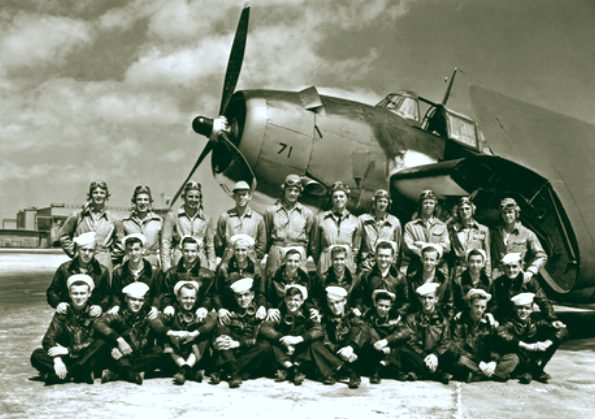
NATURAL EXPLANATIONS
Compass variations
Compass problems are one of the cited phrases in many Triangle incidents. While some have theorized that unusual local magnetic anomalies may exist in the area, such anomalies have not been found. Compasses have natural magnetic variations in relation to the
magnetic poles, a fact which navigators have known for centuries. Magnetic
(compass) north and geographic (true) north are only exactly the same for a small number of places – for example, as of 2000 in the United States only those places on a line running from Wisconsin to the Gulf of Mexico. But the public may not be as informed, and think there is something mysterious about a compass "changing" across an area as large as the Triangle, which it naturally will.
Gulf Stream
The Gulf Stream is a deep ocean current that originates in the Gulf of Mexico and then flows through the Straits of Florida into the North Atlantic. In essence, it is a river within an ocean, and, like a river, it can and does carry floating objects. It has a surface velocity of up to about 2.5 metres per second (5.6 mi/h). A small plane making a water landing or a boat having engine trouble can be carried away from its reported position by the current.
Human error
One of the most cited explanations in official inquiries as to the loss of any aircraft or vessel is
human error. Human stubbornness may have caused businessman Harvey Conover to lose his sailing yacht, the Revonoc, as he sailed into the teeth of a storm south of Florida on January 1, 1958.
Violent weather
Hurricanes are powerful storms, which form in tropical waters and have historically cost thousands of lives lost and caused billions of dollars in damage. The sinking of Francisco de Bobadilla's Spanish fleet in 1502 was the first recorded instance of a destructive hurricane. These
storms have in the past caused a number of incidents related to the Triangle.
A powerful downdraft of cold air was suspected to be a cause in the sinking of the Pride of Baltimore on May 14, 1986. The crew of the sunken vessel noted the wind suddenly shifted and increased velocity from 20 mph to 60–90 mph. A National Hurricane Center satellite specialist, James Lushine, stated "during very unstable weather conditions the downburst of cold air from aloft can hit the surface like a bomb, exploding outward like a giant squall line of wind and water." A similar event occurred to the Concordia in 2010 off the coast of Brazil.
METHANE HYDRATES
USS Cyclops
The incident resulting in the single largest loss of life in the history of the US Navy not related to combat occurred when USS Cyclops, under the command of Lt Cdr G.W. Worley, went missing without a trace with a crew of 309 sometime after March 4, 1918, after departing the island of Barbados. Although there is no strong evidence for any single theory, many independent theories exist, some blaming storms, some capsizing, and some suggesting that wartime enemy activity was to blame for the loss. In addition, two of Cyclops's sister ships, Proteus and Nereus were subsequently lost in the North Atlantic during World War II. Both ships were transporting heavy loads of metallic ore similar to that which was loaded on Cyclops during her fatal voyage. In all three cases structural failure due to overloading with a much denser cargo than designed is considered the most likely cause of sinking.
Carroll A. Deering
A five-masted schooner built in 1919, the Carroll A. Deering was found hard aground and abandoned at Diamond Shoals, near Cape Hatteras, North Carolina on January 31, 1921. Rumors and more at the time indicated the Deering was a victim of piracy, possibly connected with the illegal rum-running trade during Prohibition, and possibly involving another ship, SS Hewitt, which disappeared at roughly the same time. Just hours later, an unknown steamer sailed near the lightship along the track of the Deering, and ignored all signals from the lightship. It is speculated that Hewitt may have been this mystery ship, and possibly involved in the Deering crew's disappearance.
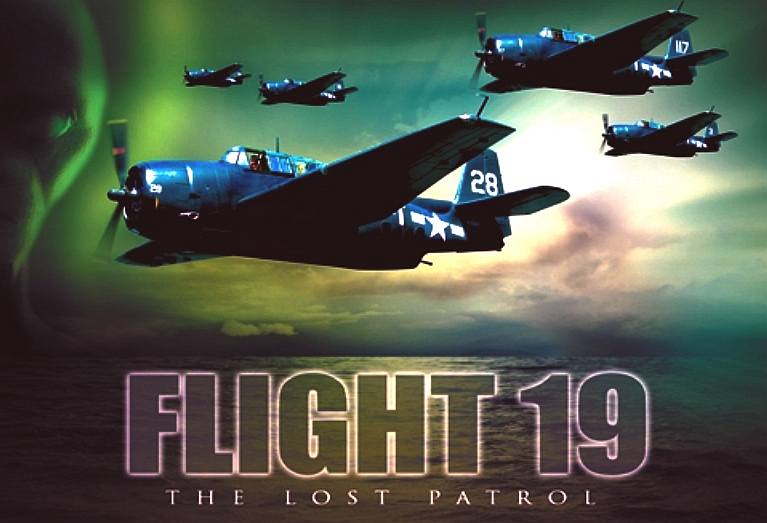
Flight 19
Flight 19 was a training flight of five TBM Avenger torpedo bombers that disappeared on December 5, 1945, while over the Atlantic. The squadron's flight plan was scheduled to take them due east from Fort Lauderdale for 141 miles, north for 73 miles, and then back over a final 140-mile leg to complete the exercise. The flight never returned to base. The disappearance is attributed by Navy investigators to navigational error leading to the aircraft running out of fuel.
One of the search and rescue aircraft deployed to look for them, a PBM Mariner with a 13-man crew, also disappeared. A tanker off the coast of Florida reported seeing an explosion and observing a widespread oil slick when fruitlessly searching for survivors. The weather was becoming stormy by the end of the incident. According to contemporaneous sources the Mariner had a history of explosions due to vapour leaks when heavily loaded with fuel, as for a potentially long search and rescue operation.
Star Tiger and Star Ariel
G-AHNP Star Tiger disappeared on January 30, 1948 on a flight from the Azores to Bermuda; G-AGRE Star Ariel disappeared on January 17, 1949, on a flight from Bermuda to Kingston, Jamaica. Both were Avro Tudor IV passenger aircraft operated by British South American Airways. Both planes were operating at the very limits of their range and the slightest error or fault in the equipment could keep them from reaching the small island. One plane was not heard from long before it would have entered the Triangle.
Douglas DC-3
On December 28, 1948, a Douglas DC-3 aircraft, number NC16002, disappeared while on a flight from San Juan, Puerto Rico, to Miami. No trace of the aircraft or the 32 people on board was ever found. From the documentation compiled by the Civil Aeronautics Board investigation, a possible key to the plane's disappearance was found, but barely touched upon by the Triangle writers: the plane's batteries were inspected and found to be low on charge, but ordered back into the plane without a recharge by the pilot while in San Juan. Whether or not this led to complete electrical failure will never be known. However, since piston-engined aircraft rely upon magnetos to provide spark to their cylinders rather than a battery powered ignition coil system, this theory is not strongly convincing.
KC-135 Stratotankers
On August 28, 1963, a pair of US Air Force KC-135 Stratotanker aircraft collided and crashed into the Atlantic. The Triangle version (Winer, Berlitz, Gaddis) of this story specifies that they did collide and crash, but there were two distinct crash sites, separated by over 160 miles (260 km) of water. However, Kusche's research showed that the unclassified version of the Air Force investigation report stated that the debris field defining the second "crash site" was examined by a search and rescue ship, and found to be a mass of seaweed and driftwood tangled in an old buoy.
Connemara IV
A pleasure yacht was found adrift in the Atlantic south of Bermuda on September 26, 1955; it is usually stated in the stories (Berlitz, Winer) that the crew vanished while the yacht survived being at sea during three hurricanes. The 1955 Atlantic hurricane season shows Hurricane Ione passing nearby between the 14th and 18th of that month, with Bermuda being affected by winds of almost gale force.
Influence on culture
The Sea World amusement park on the Gold Coast (Australia) operated a ride called Bermuda Triangle.
Composer Isao Tomita released an album, Bermuda Triangle, inspired by the region.
Singer Songwriter Barry Manilow released a single "Bermuda Triangle" in 1981, taken from his 1980 album Barry.
The first film based on the Triangle was The Bermuda Triangle in 1978. Later films include The Triangle in 2001 and The Triangle (a TV miniseries) in 2005.
In a Season 4 episode of the TV show Quantum Leap, the show's main character encounters The Bermuda Triangle while flying passengers in a small plane.
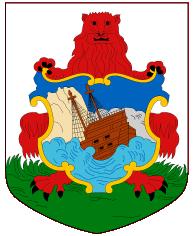
Bermud as
Coat of Arms
LINKS
and RESOURCES
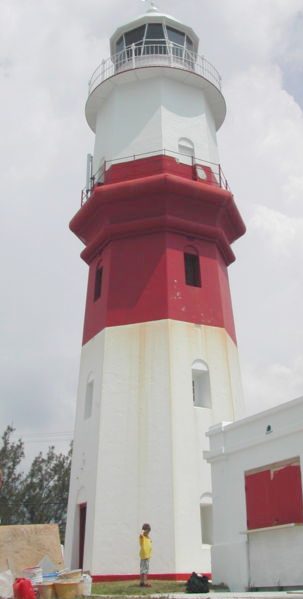
Saint
David's Lighthouse, Bermuda
|
Adelaide
Aden
- Yemen
Afghanistan
Africa
- Central
- East
Alaska
Algeria
Amsterdam
Antarctic
- Antarctica
Arctic
- North
Pole
Argentina
Asia
Athens
Atlantis
- Plato's Lost City
Australia
Austria
Aztecs
- Mexico
Bahamas
- Crooked
Island
Bangladesh
Baghdad
Bahrain
Barbados
Beachy
Head, England
Belgium
Berlin
Bermuda
Black
Rock Desert,
Nevada
Bohemia
Bolivia
Bonneville,
Utah - History
Brazil
Brighton
- West Pier
British
Columbia
Bulgaria
Burma
California
Canada
Canary
Islands
Cape
Hope
Cape
York - Au
Caribbean
- Central
America
Cayman
Islands
Chichester
Harbour
Chile
China
- Beijing
Columbia
- S. America
Columbo
- Sri Lanka
Corfu
-
Cowes,
Isle of Wight
Croatia
Cuba
Cyprus
Czechoslovakia
Darwin
- Australia
Daytona
Beach -
Florida USA
Denmark
Dubai
Eastbounre
Pier, England
Earthquakes
East
Africa
Egypt
Equador
Equator
Europe
Falkland
Islands
Falmouth,
Cornwall
Fiji
Finland
Florida
France
Galapagos
Islands
Geography
Links
Geography
Records
|
Geography
Resources
Geography
Statistics
Germany
Gibraltar
- Links
Greece
Greenland
Hampshire
Hawaii
Holland
- Volendam
Hollywood,
California, LA
Hong
Kong
Hungary
Hurricanes
Iceland
India
- Mumbai
Indonesia
Links
Iran
Iraq
Ireland
Isle
of Man
Isle
of Wight - The
Needles
Israel
Italy
Jakarta
- Java
Jamaica
Japan
Jordan
Kent,
England -
Sandgate
Kenya
Korea
Republic
of (South)
Kuwait
Kyoto
- Japan
Las
Vegas -
Lebanon
Libya
Life
on Earth
London
- Big
Ben
London
Eye - Madame
Tussauds
London
Houses
Parliament
London
- Buckingham
Palace
London
- Old
Bailey
London
- Overview
London
- The City
London
- Tower Bridge
London
- Trafalgar
Square
Luxembourg
Malaysia
Malta
Maya
Empire -
Central America
Melbourne,
Australia
Mexico
Middle
East
Monaco
Morocco
Mountains
Naples-
Italy
National
Geographic
Nepal
Nertherlands
- Eindhoven
New
York
New
Zealand
Nigeria
North
Africa
Norway
Nova
Scotia
Oceans
and Seas
Oman
Pakistan
Palermo
- Sicily
Palestine
Palma
- Malorca
|
Panama
Canal - Links
Paris
Pendine
Sands -
Carmarthen
Peru
Philippines
Pisa
Planet
Earth
Poland
Port
Moresby - PNG
Port
Said - Egypt
Portugal
Puerto
Rico
Qatar
Quebec
Rio
de Janeiro
Romania
Rome
Russia
Salt
Lake City -
Utah
Samoa
Saudi
Arabia
Scotland
Senegal
West Africa
Singapore
Somalia
South
Africa
South
America
Southampton
Spain
- Espana
Sri
Lanka - Links
Stonehenge
Suez
Canal
Sudan
Surrey,
England Index
Sussex,
England Index
Sweden
Switzerland
Sydney,
Australia
Syria
Tahiti
- Polynesia - Links
Taiwan
Thailand
Tokyo,
Japan
Tonga
- Polynesia
Toronto
Trinidad
- Lesser Antilles
Tsunami
Tunbridge
Wells, England
Tunisia
Turkey
UAE
- United Arab Emirates
UK
Statistics
Ukraine
United
Kingdom
United
Kingdom -
Gov
Uruguay
- South America
USA
Vatican
City
Venezuela
Venice
Vienna
Vietnam
Volcanoes
Wales
- Bridgend
Washington
D.C.
Wealden
iron industry
Wendover,
Utah
West
Africa
World
Peace Supporters
Yemen
Yugoslavia
Zurich
|
Solar
Cola drinkers care about planet
earth
..
Thirst for Life

(330ml
Planet Earth can)
|









